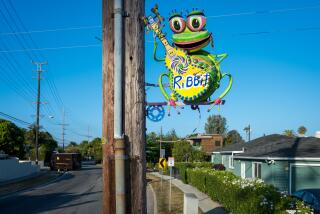The Art of Rejection : Escondido Says No to Public Sculpture Ideas
The Escondido Public Art Commission on Monday rejected all three sculpture proposals for the city’s northern entrance, saying none of them adequately express a unique gateway to the city.
Public reaction to the three submissions--on display as models at City Hall over the summer--was mixed, officials said.
The proposal by UC San Diego sculpture professor Italo Scanga included a multicolored, 32-foot-high human figure holding a banner showing local produce such as avocados, oranges and lemons.
Christopher Sproat of New York submitted a 30-foot-high clock tower fronted by a sculpture of a deer-like animal.
Mauro Staccioli of Milan, Italy, proposed an 88-foot-long, 50-foot-high curve of painted steel.
Commission chairwoman Louise Thurber and consultant Susan Pollack acknowledged that the long, triangular site at the southwest corner of El Norte and Centre City parkways is a difficult one for any artist to utilize in that it requires extensive landscaping and a distinct design to stand out amid heavy traffic and various residential and commercial structures nearby.
“I think we had three really good people,” Thurber said after the 7-0 vote at the commission’s regular monthly meeting. “It’s just that it didn’t seem to work on the site as well as we wanted it to.
“We wanted them to get the flavor of the city,” she said. “This should be a landmark, because this is an entry to the city.”
There was also concern that people could climb on Sproat’s animal sculpture, Pollack said.
Thurber said that, despite the site’s drawbacks, the commission decided to stick with the 30,000-square-foot, city-owned parcel, which is partially fenced off and covered with dirt and weeds.
“I think it’s a terrible place we had to work with,” Scanga said, adding that he was disappointed and somewhat confused by the wholesale rejection. “I feel bad because they rejected all three of us. . . . They don’t like anything.”
He said of his own piece: “They would have had a specific monument to give them some kind of identity. It was a piece about the locality. . . . I wanted people to enjoy what nature is giving us.”
The nine-member commission next week will examine its extensive slide collection of the works of other artists and, if necessary, will go beyond that to yet more artists, then probably will ask just one artist to submit a proposal rather than open it up to competition, Thurber said. Sproat, Scanga and Staccioli will not be asked to rework their proposals, officials said.
“We’re just starting over with another artist,” Thurber said.
An ad hoc committee of three arts professionals had helped the commission pick the three men in January after reviewing slides of about 20 artists’ works. Each artist received $5,000 for his model and technical work.
The models were exhibited at City Hall, the Las Villas Del Norte retirement home across from the site and at two public fairs, with the public encouraged to give written comments. Pollack said there was at least as much positive feedback as negative, and she said much of the negative comment had to do with spending $170,000 for public art.
The money comes from developer fees and is specifically earmarked for public art, she and Thurber said. The sculpture would be the city’s most expensive public work; the sculpture titled “Community” on the city’s western side is its priciest city commission to date at $64,000; it depicts various figures with outstretched arms.
While the commissioners took the public comments into consideration, they were not the deciding factor, Thurber and Pollack said.
Eleven public art projects have been erected in Escondido since 1987, three of them picked by the commission and then approved by the City Council. The rest were privately commissioned by developers. Thurber said the commission is considering sites for other projects, and would eventually like to have projects on all four sides of the city.
More to Read
The biggest entertainment stories
Get our big stories about Hollywood, film, television, music, arts, culture and more right in your inbox as soon as they publish.
You may occasionally receive promotional content from the Los Angeles Times.










